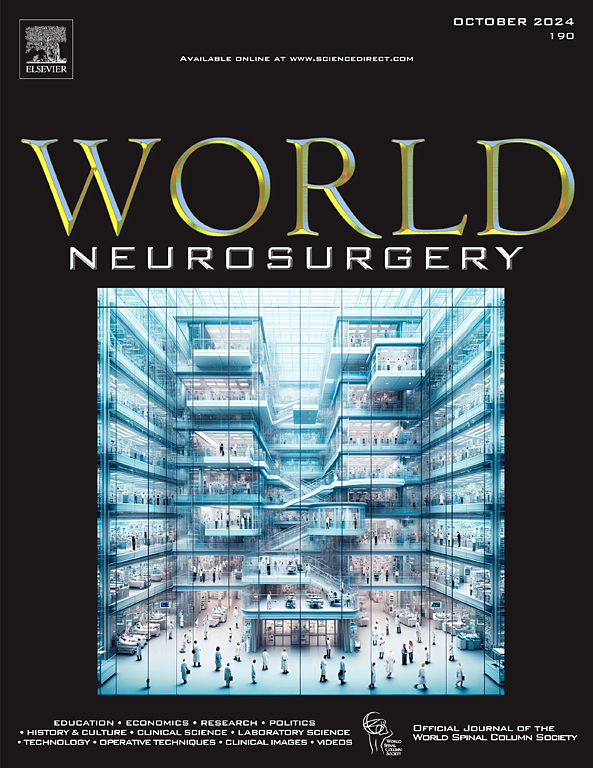未破裂颅内动脉瘤线圈栓塞后双能CT脑对比染色:频率、危险因素及临床意义。
IF 1.9
4区 医学
Q3 CLINICAL NEUROLOGY
引用次数: 0
摘要
目的:脑对比染色(CCS)后血管内手术可能模拟蛛网膜下腔出血。本研究使用双能计算机断层扫描(DECT)研究未破裂颅内动脉瘤线圈栓塞后的CCS频率和危险因素。方法:回顾性分析2018年10月至2023年3月期间接受线圈栓塞和立即DECT成像的232例患者。CCS被定义为碘叠加图像上的超衰减,在虚拟非对比度图像上不存在。Logistic回归确定了CCS的预测因子。结果:95例(40.9%)患者发生CCS,以前循环动脉瘤为主(48.1%),后循环动脉瘤为主(14.3%,p = 0.001)。高CCS发生率主要发生在后交通动脉瘤(59.1%)和前交通/大脑前动脉动脉瘤(59.0%)。低渗透压造影剂的CCS发生率(56.4%)高于等渗透压造影剂(30.4%,p < 0.001)。ccs阳性患者造影剂体积更高(186.35±46.62 mL vs. 171.62±34.89 mL);P = 0.009)和较长的手术时间(158.41±41.25分钟vs 135.28±35.07分钟,P < 0.001)。多变量分析确定后交通动脉瘤、低渗造影剂、手术时间和造影剂体积是独立的CCS预测因素。人口统计学因素与血压变异性无关。发生短暂性对比剂脑病1例;未发现出血。结论:CCS在线圈栓塞后很常见,尤其是手术时间较长、前动脉瘤和低渗造影剂的患者。DECT能有效区分CCS和出血,潜在地减少不必要的后续成像。本文章由计算机程序翻译,如有差异,请以英文原文为准。
Cerebral Contrast Staining on Dual-Energy Computed Tomography After Coil Embolization of Unruptured Intracranial Aneurysms: Frequency, Risk Factors, and Clinical Implications
Objective
Cerebral contrast staining (CCS) postendovascular procedures may mimic subarachnoid hemorrhage. This study investigates CCS frequency and risk factors using dual-energy computed tomography (DECT) following coil embolization of unruptured intracranial aneurysms.
Methods
A retrospective analysis included 232 patients undergoing coil embolization and immediate DECT imaging between October 2018 and March 2023. CCS was defined as hyperattenuation on iodine overlay images absent on virtual noncontrast images. Logistic regression identified predictors of CCS.
Results
CCS occurred in 95 patients (40.9%), predominantly in anterior circulation aneurysms (48.1%) compared to posterior circulation (14.3%, P = 0.001). High CCS rates occurred particularly in posterior communicating (59.1%) and anterior communicating/anterior cerebral artery aneurysms (59.0%). Low-osmolar contrast media had higher CCS incidence (56.4%) compared to iso-osmolar media (30.4%, P < 0.001). CCS-positive patients had higher contrast volume (186.35 ± 46.62 mL vs. 171.62 ± 34.89 mL; P = 0.009) and longer procedures (158.41 ± 41.25 vs. 135.28 ± 35.07 min, P < 0.001). Multivariate analysis identified posterior communicating artery aneurysms, low-osmolar contrast media, procedure duration, and contrast volume as independent CCS predictors. Demographic factors and blood pressure variability were unrelated. One transient contrast-induced encephalopathy case occurred; no hemorrhages were identified.
Conclusions
CCS is common after coil embolization, especially with longer procedures, anterior aneurysms, and low-osmolar contrast media. DECT effectively differentiates CCS from hemorrhage, potentially reducing unnecessary follow-up imaging.
求助全文
通过发布文献求助,成功后即可免费获取论文全文。
去求助
来源期刊

World neurosurgery
CLINICAL NEUROLOGY-SURGERY
CiteScore
3.90
自引率
15.00%
发文量
1765
审稿时长
47 days
期刊介绍:
World Neurosurgery has an open access mirror journal World Neurosurgery: X, sharing the same aims and scope, editorial team, submission system and rigorous peer review.
The journal''s mission is to:
-To provide a first-class international forum and a 2-way conduit for dialogue that is relevant to neurosurgeons and providers who care for neurosurgery patients. The categories of the exchanged information include clinical and basic science, as well as global information that provide social, political, educational, economic, cultural or societal insights and knowledge that are of significance and relevance to worldwide neurosurgery patient care.
-To act as a primary intellectual catalyst for the stimulation of creativity, the creation of new knowledge, and the enhancement of quality neurosurgical care worldwide.
-To provide a forum for communication that enriches the lives of all neurosurgeons and their colleagues; and, in so doing, enriches the lives of their patients.
Topics to be addressed in World Neurosurgery include: EDUCATION, ECONOMICS, RESEARCH, POLITICS, HISTORY, CULTURE, CLINICAL SCIENCE, LABORATORY SCIENCE, TECHNOLOGY, OPERATIVE TECHNIQUES, CLINICAL IMAGES, VIDEOS
 求助内容:
求助内容: 应助结果提醒方式:
应助结果提醒方式:


